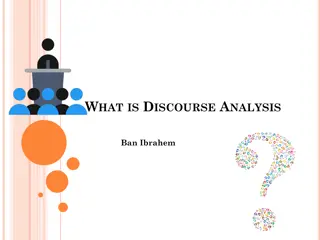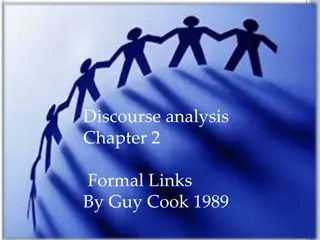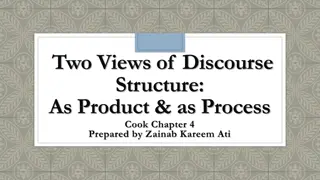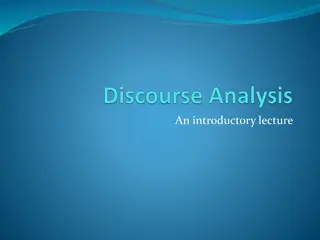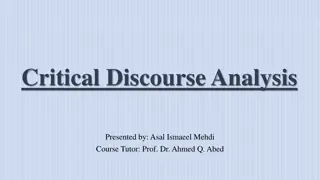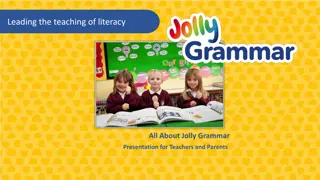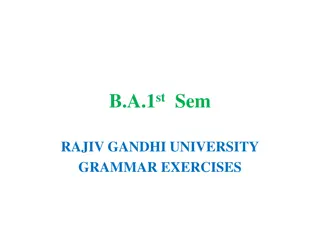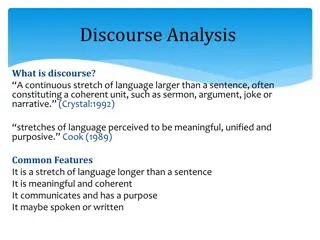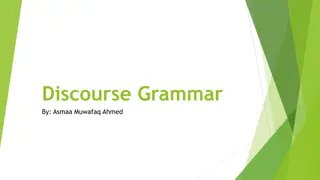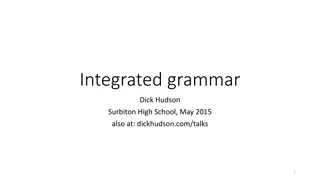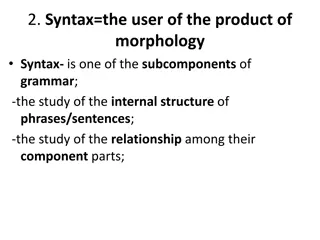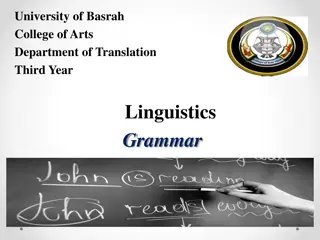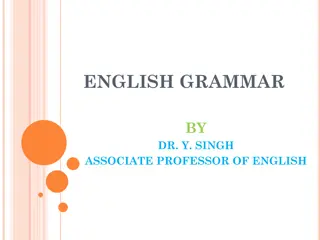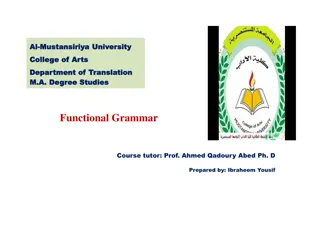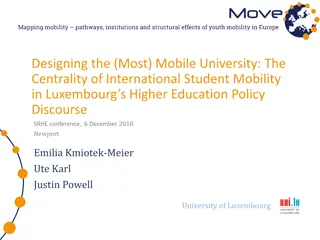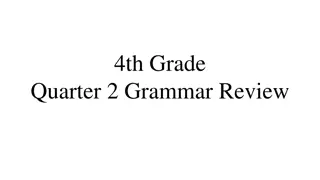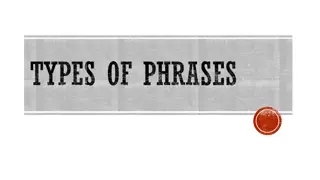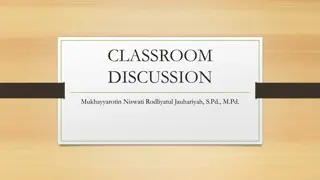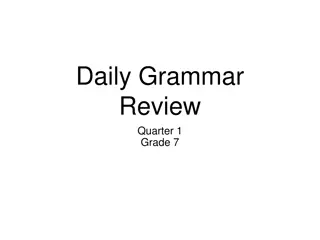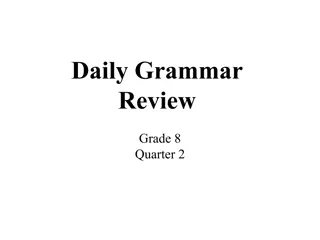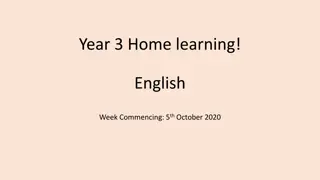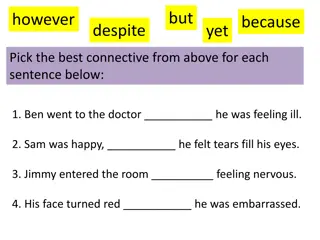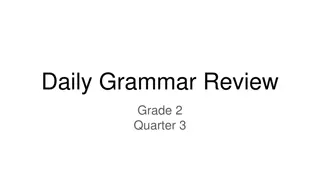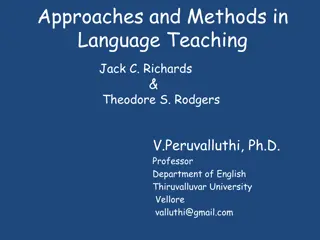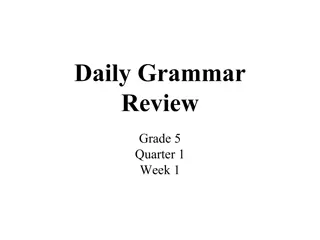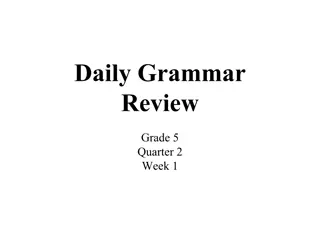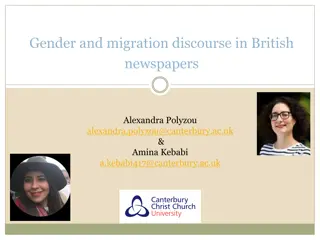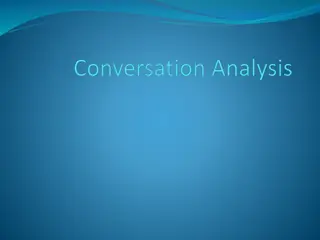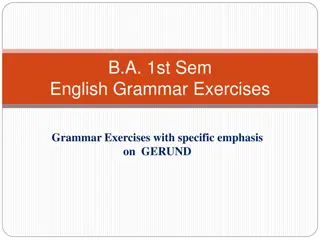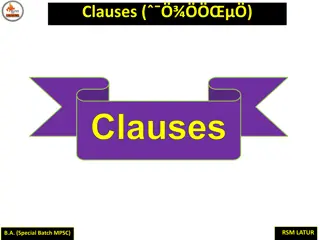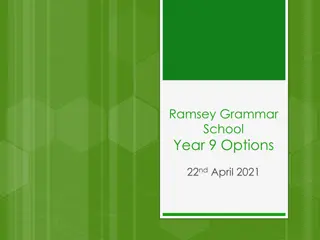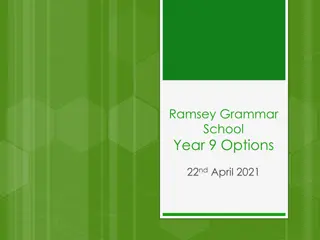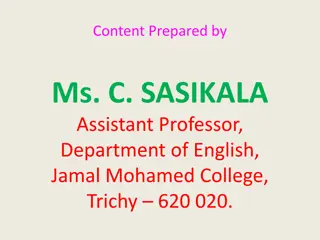Understanding Grammar in Discourse: A Comprehensive Analysis
Recent discourse-based perspectives on grammar discuss how linguistic items exhibit diverse patterns when analyzed within longer texts. Scholars like Hughes, McCarthy, Halliday, and Hassan emphasize the cohesion and unity of texture in text through grammar and vocabulary patterns, connecting meanings within the context. Additionally, insightful studies by McCarthy, Celce-Murcia, and Olshtain highlight the varied functions of pronouns, tenses, and modal verbs when viewed from a discourse perspective, shedding light on their use beyond traditional explanations.
Download Presentation

Please find below an Image/Link to download the presentation.
The content on the website is provided AS IS for your information and personal use only. It may not be sold, licensed, or shared on other websites without obtaining consent from the author. Download presentation by click this link. If you encounter any issues during the download, it is possible that the publisher has removed the file from their server.
E N D
Presentation Transcript
Discourse Grammar Discourse Grammar Prepared by: Asal Ismaeel Course Tutor: Prof. Dr. Ahmed Q. Abed
Content Introduction 6.1 Grammar from Discourse Perspective 6.2 The texture of a text 6.3 Cohesion and Discourse 6.4 Reference 6.5 Lexical Cohesion 6.6 Collocation 6.7 Conjunction
Introduction In recent years discussions of grammar have moved from sentence-based perspectives to more of a discourse-based perspective. 1. Hughes & McCarthy (1998): Both argued that traditional explanations of grammar do not adequately capture grammatical selection in longer, real-world texts. As they have shown, a number of linguistic items show quite different patterns of use when looked at from a discourse perspective. 2. Halliday and Hassan: Both have also done work in the area of discourse grammar, although from rather a different perspective. Their interest has been in patterns of grammar and vocabulary that: (1) combine to tie meanings in the text together as well as (2) connect the text to the social context in which it occurs; that is, (3) items that combine together to make the text cohesive and give it unity of texture.
6.1 Grammar from Discourse Perspective 1. it, this and that All show different patterns of use when looked at from a discourse perspective, rather than a sentence perspective. McCarthy (1994): - It: often signals reference to a continuing or ongoing topic in a text, rather than just something inside or outside the text, as more traditional explanations might suggest. - This: often indicates the raising of a new topic or a new focus in the current topic. - That: has a distancing or marginalizing function in a text, rather than just demonstrative functions.
McCarthy (1998): Also found similar differences in relation to the use of Tenses : (Past Perfect) 1. the use of be to with future meaning. 2. Wh-cleft constructions (as in What you need is . . . ). Celce-Murcia ( 1997 ): 1. Argued for contextual analyses that look at grammatical form in relation to where, why and how frequently it is used in written and spoken discourse rather than in isolated sentences. 2. She makes a similar argument to McCarthy about this and that showing how, in extended texts, this and that: function in ways other than just pointing to something. 3. She also shows how tense and aspect choices differ in extended discourse.
Celce-Murcia and Olshtain (2000): be going to & will 1. Discuss how be going to and will , when looked at from a discourse perspective: Show different functions other than just the expression o future time. 2. They found be going to : is typically used when English speakers narrate future scenarios, which they then follow with a contracted form of will , for example. 3. They also found the present simple is often used alongside will to add descriptive details to the future event being recounted.
Discourse-based Grammar Properties Hughes and McCarthy (1998) make a helpful comparison between discourse and sentence-based grammars. 1. A discourse-based grammar, makes a strong connection between form, function and context. 2. Aims to place appropriateness. 3. Use at the centre of its descriptions. Larsen-Freeman (2003) makes a similar argument in her view that form, meaning and use need to be at the basis of all grammatical descriptions. 4. A discourse-based grammar, acknowledges language choice. 5. Promotes awareness of interpersonal factors in grammatical choice. 6. Can provide insights into areas of grammar that, previously, lacked a satisfactory explanation.
Discourse-based Analyses Aspects of language are especially suitable to this view include: ellipsis and tense-function correlations. Discourse-based analyses are also useful for: 1. Looking at the relationship between vocabulary items in texts. 2. The relationship between items such as it and others and the items they are referring to inside or outside of the text, and conjunction.
6.2 The texture of a text Hasan ( 1989a , 1989b ) discusses two crucial attributes of texts and which are important for the analysis of discourse. These are: 1. Unity of structure 2. Unity of texture Unity of structure: refers to patterns which combine together to create information structure, focus and flow in a text, including the schematic structure of the text.
Unity of Texture Unity of texture refers to the way in which resources such as patterns of cohesion create both cohesive and coherent texts. Q- Where does texture result? A- Texture results where there are: language items that (1) tie meanings together in the text as well as (2) tie meanings in the text to the social context in which the text occurs. Example:An example of this is where the meaning of items that refer outside of the text, such as it and that , can be derived from the social context in which the text is located.
So, What is Texture? Texture: is a result of the interaction of these kinds of features.(Halliday 2009b) Texture: a matter of meaning relations . (Hasan 1989b : 71) A crucial notion in this discussion is that of a tie which connects: 1. the meanings of words to each other; 2. as well as to the world outside the text. The basis for cohesion, and in turn texture, thus, is semantic. It is both explicit and implicit and is based in the ways in which the meanings of items are tied in a semantic relationship to each other. The interpretation of these items is found by reference to some other item, or source, within or outside the text.
- How? Give me an Example? In the following sentence, for example.. I use my knowledge of the text and the context in which it is located to work out what it is referring to in the text: (in this case, gravy) Waiter: Where would you like it sir? Customer: Just a little on the meat thanks.
6.3 Cohesion and Discourse An area of language in which grammar and discourse are highly integrated is in patterns of cohesion in texts. Q- What are the main patterns of Cohesion? A- The main patterns of cohesion are: Lexical Cohesion Reference Conjunction Ellipsis Substitution
Cohesion: refers to the relationship between items in a text such as words, phrases and clauses and other items such as pronouns, nouns and conjunctions. 1. This includes the relationship between words and pronouns that refer to that word (reference items). 2. It also includes words that commonly co-occur in texts (collocation) 3. The relationship between words with similar, related and different meanings (lexical cohesion). 4. Cohesion also considers semantic relationships between clauses and the ways this is expressed through the use of conjunctions. 5. A further aspect of cohesion is the way in which words such as one and do are used to substitute for other words in a text (substitution) 6. and the ways in which words or phrases are left out, or ellipsed, from a text (ellipsis). All of this contributes to the unity of texture of a text and helps to make the text cohesive.
6.4 Reference Reference: refers to the situation where the identity of an item can be retrieved from either within or outside the text. The Main reference patterns are: The Secondary reference patterns are: Anaphoric Comparative Cataphoric Bridging Exophoric Homophoric
1. Anaphoric Reference Anaphoric reference: is where a word or phrase refers-back to another word or phrase used earlier in a text. Example: It seems everyone s read that self-help book: Greg Behrendt and Liz Tuccillo s He s Just Not That Into You . . . First in the US, then all over the world, women became converts to the book s tough-love message. When it was published late last year, Oprah sang its praises, tearful women called it the Bible , and others declared it had changed their lives forever. (Cooper 2005 : S38) Explanation: the book s though-love message , it and it are all referring to the same book He s just not that into you It s obvious to the hearer/ reader, that the speaker/writer doesn t have to repeat the title or name of the book, but to refer to it by it or other words.. This is called Anaphoric Reference.
2. Cataphoric Reference Cataphoric reference: describes an item which refers forward to another word or phrase which is used later in the text. Example: It seems everyone s read that self-help book: Greg Behrendt and Liz Tuccillo s He s Just Not That Into You. (ibid.) Explanation: the identity of the italicized that follows, rather than precedes, the book s title which is the reference item. In this case, the reader knows the item being referred to is yet to come in the text and reads forward to find the meaning of that .
3. Exophoric Reference Exophoric reference: looks outside the text to the situation in which the text occurs for the identity of the item being referred to. Example: Customer: What kind of book would you say this is? Where would you put it on your bookshelves? Explanation: Both speakers clearly know what book is being referred to in this conversation ( Monica s Story ). You and your are also examples of exophoric reference. Both speakers know, from outside the text, who these items are referring to..
4. Homophoric Reference Homophoric reference: is where the identity of the item can be retrieved by reference to cultural knowledge, in general, rather than the specific context of the text. Example: First in the US, then all over the world, women became converts to the book s tough- love message. (ibid.) Explanation: This is different from the final use of the in this sentence. To answer which book we know it is the one being discussed in the text. We know, however, from our cultural knowledge which United States and which world are being referred to in the text.
5. Comparative Reference Comparative reference: the identity of the presumed item is retrieved not because it has already been mentioned or will be mentioned in the text, but because an item with which it is being compared has been mentioned (Eggins 2004 : 35). Example: When it was published late last year, Oprah sang its praises, tearful women called it the Bible , and others declared it had changed their lives forever. The book assumes all men are confident, or that if they really like a girl, they ll overcome their shyness. The opposite is true. (Cooper 2005 : S38) Explanation: The author proceeds, however, on the assumption that we will know which people and that we will know which opposite she is referring to.
6. Bridging Reference Bridging reference: is where an item refers to something that has to be inferentially derived from the text or situation; that is, something that has to be presumed indirectly. (Martin 1992 , Martin and Rose 2007) Example: Stuart agrees. I was hopeless , he says with a laugh. I m just not one of those blokes that finds approaching women easy. (Cooper 2005 : S38) Explanation: we are not told which blokes Stuart is referring to. The author presumes that we can indirectly derive this..
6.5 Lexical Cohesion Lexical cohesion: refers to relationships in meaning between lexical items in a text and, in particular, content words and the relationship between them. The main kinds of lexical cohesion are: Antonymy Meronymy Repetition Collocation Synonymy Hyponymy
1. Repetition Repetition: refers to words that are repeated in a text. This includes words which are inflected for tense or number and words which are derived from particular items. Example: Jen Abydeera, 27, and Stuart Gilby, 22, . . . are convinced they wouldn t be a couple if Jen had done things the [He s Just Not That Into You] way when they first met. Stu was quiet and shy, while I was more confident and forward, says Jen. He was more reluctant than I was to ask questions or to initiate a date. I would be the one to say to him: When do you want to go out, then? (ibid.) Explanation: Stuart and Stu in the example. Although the form of these two items is (slightly) different, the author is certain that it will be clear that she is still referring to the same person.
Synonymy & Antonymy 2. Synonymy: refers to words which are similar in meaning. Example: (Date) and (Go out). In English it is not good style to continuously repeat the same word in a text. Both Date and Go out are referring to the same concept but in a different way. 3. Antonymy: describes opposite or contrastive meanings. Example: (Shy) and (Forward), (Men) and (Women), (Real players) and (Boofheads) We know as we read the words which meanings contrast with each other. Part of their meaning, indeed, derives from this contrast.
Hyponymy and Meronymy Halliday ( 1990 ) describes two kinds of lexical taxonomies that typically occur in texts: superordination and composition . Superordination: are words which are in a kind-of relationship with each other Composition: are words that are in a whole-part relationship with each other.
4. Hyponymy: refers to classes of lexical items where the relationship between them is one of general-specific , an example of or in a class to member type relationship. Example: 5. Meronymy: is where lexical items are in a whole-to-part relationship with each other. Example:
6.6 Collocation Collocation: describes associations between vocabulary items which have a tendency to co-occur such as combinations of adjectives and nouns. Example: Collocation is not something that is restricted to a single text but is part of textual knowledge in general. A writer and speaker of a language draws on this knowledge of collocations as he/she writes and speaks. Expert writers (and readers) know that only certain items collocate with each other. That is, we know we can say real-estate agent but not real-estate fruit and vegetables . Or that we can say fresh fruit and vegetables but not (with the same meaning) fresh real-estate agents . This knowledge of collocation is another way in which a text has the property of texture.
1. Expectancy Relations A further kind of relationship, related to collocation, is expectancy relations . This occurs where there is a predictable relationship between a verb and either the subject or the object of the verb. These relations link nominal elements with verbal elements (e.g. love/book, waste/time) They can also link an action with a participant (e.g. ask/guy) or an event with its location (e.g. dating/sites). Expectancy can also refer to the relationship between individual lexical items and the composite nominal group that they form (e.g. art/classes, life/drawing, online/dating).
2. Lexical Bundles Lexical bundles: are multi-word combinations such as (as a result of), (on the other hand) , (if you look at) and (as can be seen) that occur in genres such as university textbooks, academic essays, theses and dissertations, and research articles, as well as spoken genres such as academic lectures and conversation. Byrd and Coxhead ( 2010 ) define lexical bundles as three or more words that occur in fixed or semi-fixed combinations that are repeated without change for a set number of times in a particular corpus
Lexical Bundle Functions They can express stance such as certainty, possibility and probability as in: (I don t know if) and (I don t think so) . They can express speaker attitude towards actions as in: ( I want you to) and (I m not going to) . They can express desire: ( I don t want to ) Obligation ( you have to do ) Intention ( what we re going to ). Lexical bundles can also have a discourse organizing focus as in (What I want to do) and (If we look at). Lexical bundles can also be multi-functional in that they can be both directives and topic introducers (as in take a look at ) and a time, place and textual reference, as in (the beginning of the) and (at the end of).
6.7 Conjunction Conjunction refers to words, such as and , however , finally and in conclusion that join phrases, clauses or sections of a text in such a way that they express the logical-semantic relationship between them. They are a further important part of discourse knowledge that both speakers and writers, and readers and listeners, draw on as they both produce and interpret spoken and written discourse. Conjunctions are described by Halliday and Hasan under the groupings of: (1) Additive. (2) Adversative (3) Causal (4) Temporal Martin ( 1992 ) and Martin and Rose discuss conjunctions under the categories of: (1) Additive (2) Comparative (3) Temporal (4) Consequential
Frame Markers Vande Kopple talks about text connectives , rather than conjunctions, which are used to: indicate how parts of the text are connected to each other. Crismore, Markkanen and Steffensen discuss textual markers which help to organize discourse. Hyland adds the category of frame markers to the discussion. Frame markers: are items which (1)sequence the material in a text. (such as first and next ), (2) items which label the stages of text (such as in conclusion and finally ) (3) items which announce the goal of the discourse (such as my aim here is to . . . ) (4) items which announce a change in topic (such as well and now ). Frame markers, along with conjunction and other markers of this kind, lead the reader of a text to preferred interpretations of the text as well as help form convincing and coherent texts by relating individual propositions to each other and to other texts (Hyland 1998a : 442).
Thank You! Thank You!



